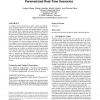178 search results - page 28 / 36 » Representing social structures in UML |
IPPS
2009
IEEE
14 years 3 months ago
2009
IEEE
Graph-theoretic abstractions are extensively used to analyze massive data sets. Temporal data streams from socioeconomic interactions, social networking web sites, communication t...
MABS
2000
Springer
14 years 5 days ago
2000
Springer
The effects of distinct agent interaction and activation structures are compared and contrasted in several multi-agent models of social phenomena. Random graphs and lattices repre...
IS
2008
13 years 8 months ago
2008
Abstract. Sharing of structured data in decentralized environments is a challenging problem, especially in the absence of a global schema. Social network structures map network lin...
NN
2008
Springer
13 years 8 months ago
2008
Springer
dely acknowledged that categorically organized abstract knowledge plays a significant role in high-order human cognition. Yet, there are many unknown issues about the nature of ho...
SCESM
2006
ACM
14 years 2 months ago
2006
ACM
As technical systems keep growing more complex and sophisticated, designing software for the safety-critical coordination between their components becomes increasingly difficult....

